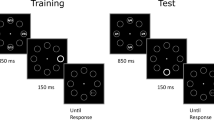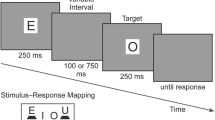Abstract
It is well known that processing at upcoming target locations can be facilitated, but mixed results have been obtained regarding the inhibition of irrelevant locations when advance information about distractors is available on a trial-to-trial basis. Here, we provide electrophysiological evidence that distractor locations can be anticipatorily suppressed. In an additional singleton search task, distractor cues were presented before the search display, which were either fully predictive or non-predictive of the location of the upcoming salient colour distractor. The PD component of the event-related potential, a marker of active suppression, was elicited by lateral singletons and smaller following predictive than non-predictive cues, indicating that less suppression was required upon presentation of the distractor when its location was known in advance. Presumably, excitability of regions processing the predictively cued locations was anticipatorily reduced to prevent distraction. This idea was further supported by the finding that larger individual cueing benefits in reaction time were associated with stronger reductions of the PD. There was no behavioural benefit at the group level, however, and implications for the role of individual differences and for the measurement of inhibition in distractor cueing tasks are discussed. The enhancement of target locations, reflected by the NT component, was not modulated by the predictiveness of the cues. Overall, our findings add to a growing literature highlighting the importance of inhibitory mechanisms for the guidance of spatial attention by showing that irrelevant locations can be anticipatorily suppressed in a top-down fashion, reducing the impact of even salient stimuli.




Similar content being viewed by others
Data availability
The datasets generated and analysed during the current study are available from the corresponding author on request.
References
Barras, C., & Kerzel, D. (2016). Active suppression of salient-but-irrelevant stimuli does not underlie resistance to visual interference. Biological Psychology, 121, 74–83.
Carrasco, M. (2011). Visual attention: The past 25 years. Vision Research, 51, 1484–1525.
Chang, S., Cunningham, C. A., & Egeth, H. (2018). The power of negative thinking: Paradoxical but effective ignoring of salient-but-irrelevant stimuli with a spatial cue. Visual Cognition, Advance online publication.
Cook, R. D. (1977). Detection of influential observations in linear regression. Technometrics, 19, 15–18.
Desimone, R., & Duncan, J. (1995). Neural mechanisms of selective visual attention. Annual Review of Neuroscience, 18, 193–222.
Eimer, M. (1996). The N2pc component as an indicator of attentional selectivity. Electroencephalography and Clinical Neurophysiology, 99, 225–234.
Feldmann-Wüstefeld, T., Uengoer, M., & Schubö, A. (2015). You see what you have learned. Evidence for an interrelation of associative learning and visual selective attention. Psychophysiology, 52, 1483–1497.
Feldmann-Wüstefeld, T., & Vogel, E. K. (2018). Neural evidence for the contribution of active suppression during working memory filtering. Cerebral Cortex.. https://doi.org/10.1093/cercor/bhx336.
Ferrante, O., Patacca, A., Di Caro, V., Della Libera, C., Santandrea, E., & Chelazzi, L. (2018). Altering spatial priority maps via statistical learning of target selection and distractor filtering. Cortex, 102, 67–95.
Fortier-Gauthier, U., Moffat, N., Dell’Acqua, R., McDonald, J. J., & Jolicœur, P. (2012). Contralateral cortical organisation of information in visual short-term memory: Evidence from lateralized brain activity during retrieval. Neuropsychologia, 50, 1748–1758.
Gaspar, J. M., Christie, G. J., Prime, D. J., Jolicœur, P., & McDonald, J. J. (2016). Inability to suppress salient distractors predicts low visual working memory capacity. Proceedings of the National Academy of Sciences, 113, 3693–3698.
Gaspar, J. M., & McDonald, J. J. (2014). Suppression of salient objects prevents distraction in visual search. Journal of Neuroscience, 34, 5658–5666.
Gaspelin, N., Leonard, C. J., & Luck, S. J. (2015). Direct evidence for active suppression of salient-but-irrelevant sensory inputs. Psychological Science, 26, 1740–1750.
Gaspelin, N., Leonard, C. J., & Luck, S. J. (2016). Suppression of overt attentional capture by salient-but-irrelevant color singletons. Attention, Perception, & Psychophysics, 79, 45–62.
Gaspelin, N., & Luck, S. J. (2018a). Combined electrophysiological and behavioral evidence for the suppression of salient distractors. Journal of Cognitive Neuroscience, 30, 1265–1280.
Gaspelin, N., & Luck, S. J. (2018b). The role of inhibition in avoiding distraction by salient stimuli. Trends in Cognitive Sciences, 22, 79–92.
Geyer, T., Müller, H., & Krummenacher, J. (2008). Expectancies modulate attentional capture by salient color singletons. Vision Research, 48, 1315–1326.
Hickey, C., Di Lollo, V., & McDonald, J. J. (2009). Electrophysiological indices of target and distractor processing in visual search. Journal of Cognitive Neuroscience, 21, 760–775.
Jannati, A., Gaspar, J. M., & McDonald, J. J. (2013). Tracking target and distractor processing in fixed-feature visual search: Evidence from human electrophysiology. Journal of Experimental Psychology: Human Perception and Performance, 39, 1713–1730.
Luck, S. J. (2012). Electrophysiological correlates of the focusing of attention within complex visual scenes: N2pc and related ERP components. In E. S. Kappenman & S. J. Luck (Eds.), The Oxford handbook of event-related potential components (pp. 329–360). Oxford: Oxford University Press.
Moher, J., Abrams, J., Egeth, H. E., Yantis, S., & Stuphorn, V. (2011). Trial-by-trial adjustments of top-down set modulate oculomotor capture. Psychonomic Bulletin & Review, 18, 897–903.
Moher, J., & Egeth, H. E. (2012). The ignoring paradox: Cueing distractor features leads first to selection, then to inhibition of to-be-ignored items. Attention, Perception, & Psychophysics, 74, 1590–1605.
Müller, H. J., Geyer, T., Zehetleitner, M., & Krummenacher, J. (2009). Attentional capture by salient color singleton distractors is modulated by top-down dimensional set. Journal of Experimental Psychology: Human Perception and Performance, 35, 1–16.
Munneke, J., Fait, E., & Mazza, V. (2013). Attentional processing of multiple targets and distractors. Psychophysiology, 50, 1104–1108.
Munneke, J., Heslenfeld, D. J., Usrey, W. M., Theeuwes, J., & Mangun, G. R. (2011). Preparatory effects of distractor suppression: Evidence from visual cortex. PLoS ONE, 6, e27700.
Munneke, J., Van der Stigchel, S., & Theeuwes, J. (2008). Cueing the location of a distractor: An inhibitory mechanism of spatial attention? Acta Psychologica, 129, 101–107.
Oostenveld, R., Fries, P., Maris, E., & Schoffelen, J. M. (2011). FieldTrip: Open source software for advanced analysis of MEG, EEG, and invasive electrophysiological data. Computational Intelligence and Neuroscience, 2011, 156869.
Posner, M. I. (1980). Orienting of attention. Quarterly Journal of Experimental Psychology, 32, 3–25.
Ruff, C. C., & Driver, J. (2006). Attentional preparation for a lateralized visual distractor: Behavioral and fMRI evidence. Journal of Cognitive Neuroscience, 18, 522–538.
Sawaki, R., Geng, J. J., & Luck, S. J. (2012). A common neural mechanism for preventing and terminating the allocation of attention. Journal of Neuroscience, 32, 10725–10736.
Sawaki, R., & Luck, S. J. (2010). Capture versus suppression of attention by salient singletons: Electrophysiological evidence for an automatic attend-to-me signal. Attention, Perception & Psychophysics, 72, 1455–1470.
Sawaki, R., & Luck, S. J. (2011). Active suppression of distractors that match the contents of visual working memory. Visual Cognition, 19, 956–972.
Wang, B., & Theeuwes, J. (2018a). How to inhibit a distractor location? Statistical learning versus active, top-down suppression. Attention, Perception, and Psychophysics, 80, 860–870.
Wang, B., & Theeuwes, J. (2018b). Statistical regularities modulate attentional capture. Journal of Experimental Psychology: Human Perception and Performance, 44, 13–17.
Wang, B., & Theeuwes, J. (2018c). Statistical regularities modulate attentional capture independent of search strategy. Attention, Perception, & Psychophysics, 80, 1763–1774.
Woodman, G. F., & Luck, S. J. (2003). Serial deployment of attention during visual search. Journal of Experimental Psychology: Human Perception and Performance, 29, 121–138.
Acknowledgements
This research was supported by the Deutsche Forschungsgemeinschaft (DFG, German Research Foundation—project number 222641018—SFB/TRR 135, TP B3) and was conducted while the first author was at Philipps-Universität Marburg. The authors would like to thank Aylin Hanne for assistance with data collection and valuable discussions.
Author information
Authors and Affiliations
Corresponding author
Ethics declarations
Conflict of interest
The authors declare that they have no conflict of interest.
Ethical approval
All procedures were approved by the Ethics Committee of the Faculty of Psychology at Philipps-Universität Marburg and in accordance with the ethical standards laid down in the 1964 Declaration of Helsinki and its later amendments.
Informed consent
Informed consent was obtained from all participants.
Additional information
Publisher's Note
Springer Nature remains neutral with regard to jurisdictional claims in published maps and institutional affiliations.
Rights and permissions
About this article
Cite this article
Heuer, A., Schubö, A. Cueing distraction: electrophysiological evidence for anticipatory active suppression of distractor location. Psychological Research 84, 2111–2121 (2020). https://doi.org/10.1007/s00426-019-01211-4
Received:
Accepted:
Published:
Issue Date:
DOI: https://doi.org/10.1007/s00426-019-01211-4




